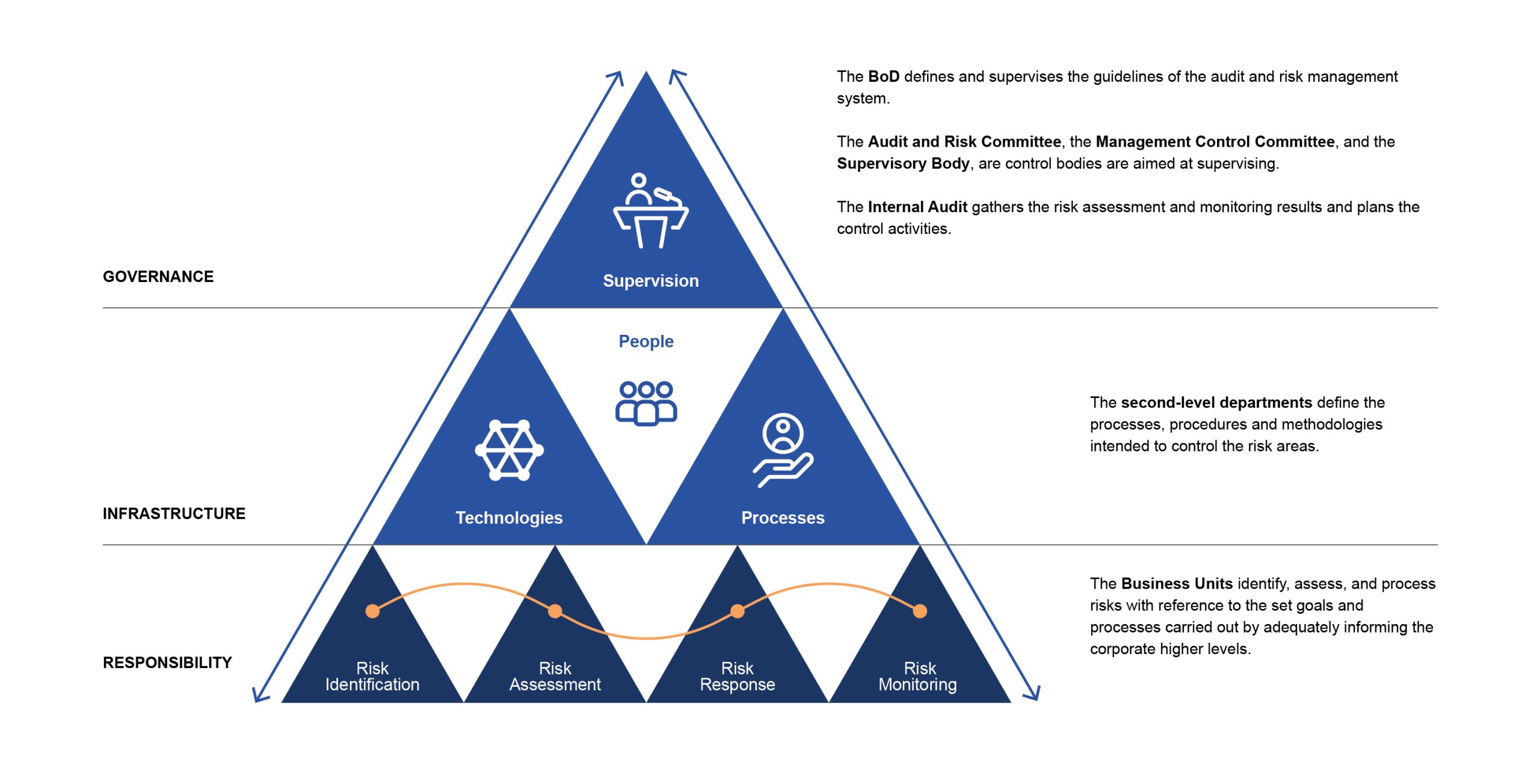Our anti-corruption policies are the result of a company management guided by the values of the Group’s code of ethics and focused on pursuing sustainable growth objectives for stakeholders
Our growth has made it necessary to progressively strengthen and further integrate the components of the internal control system. The risk governance model was developed in line with best practices and in compliance with the Corporate Governance Code for Listed Companies and the Group’s Model 231
The risk governance model was developed in line with best practices and in compliance with the Corporate Governance Code for Listed Companies and the Group’s Model 231. It is structuredon threelevels, identifies distinct roles and responsibilities for the various organisational structures and provides for an adequate exchange of information flows to ensure its effectiveness.
In order to cope with the risks to which it is exposed, the Group has equipped itself with suitable corporate governance devices and adequate management and control mechanisms; specifically, the Company’s Internal Control and Risk Management System (“SCIGR”) consists of the set of rules, procedures and organisational structures aimed at an effective and efficient identification, measurement, management and monitoring of the main corporate risks in order to contribute to the company’s sustainable success. Enterprise Risk Management processes, integrated into the company’s processes, are continuously improved with the aim of innovating and disseminating an effective organisational culture of management and mitigation.
Our Risk Governance Model
Specifically, the organisational structure aimed at managing corporate risks is structured as follows:
As a whole, plays a role in guiding and assessing the adequacy of the SCIGR. In particular, in relation to the non-financial issues covered in this Integrated Annual Report, it should be noted that the Board of Directors is first and foremost responsible for defining the SCIGR’s guidelines, in line with the strategic objectives and risk profile of the SCIGR, with a view to its sustainability in the medium-long term
Whose task is to support the assessments and decisions of the Board of Directors concerning the internal control and risk management system.
By virtue of its control activities on the adequacy of the organisational, administrative and accounting structure adopted by the company, monitors the effectiveness of the SCIGR as the “apex” of the company’s supervisory system.
The Supervisory Board pursuant to Legislative Decree No. 231/2001, which checks the adequacy of the 231 Model, paying particular attention to its effectiveness in preventing unlawful conduct and carries out constant supervision of the application of and compliance with the 231 Model.
Which systematically verifies the effectiveness and efficiency of the Internal Control and Risk Management System as a whole (third-level control body), reporting the results of its activities to top management and coordinating with the other corporate control bodies.
As a second-level control body, carries out periodic checks on the companies’ compliance with regulations, by verifying, in accordance with industry best practices, the compliance of the activities carried out with the statutory provisions, the provisions of the Supervisory Authorities, the self-regulatory rules and regulations, as well as the contractual commitments undertaken with customers.
Confirming the overall effectiveness of the integrity and compliance measures adopted by the Group, as at 30 April 2024 there have been no episodes of corruption, conduct in breach of the law on competition or other applicable socio-economic and environmental regulations, nor had the Supervisory Board of Sesa received any reports of alleged unlawful conduct or conduct contrary to the provisions of the Code of Ethics.

